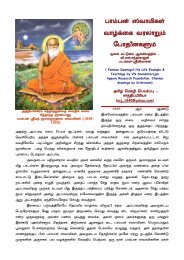Cult of the Child-God Crosses a Millennial Milestone
Cult of the Child-God Crosses a Millennial Milestone
Cult of the Child-God Crosses a Millennial Milestone
You also want an ePaper? Increase the reach of your titles
YUMPU automatically turns print PDFs into web optimized ePapers that Google loves.
<strong>Cult</strong> <strong>of</strong> <strong>the</strong> <strong>Child</strong>-<strong>God</strong> <strong>Crosses</strong> a <strong>Millennial</strong> <strong>Milestone</strong><br />
<strong>Cult</strong> <strong>of</strong> <strong>the</strong> <strong>Child</strong>-<strong>God</strong><br />
<strong>Crosses</strong> a <strong>Millennial</strong><br />
<strong>Milestone</strong><br />
by Patrick Harrigan<br />
In truth, <strong>the</strong> composite deity Skanda-Murukan is two<br />
gods combined in one or, ra<strong>the</strong>r, two deities yet one<br />
indivisible <strong>God</strong>. As such, he is a perplexing god <strong>of</strong><br />
paradox and apparent contradictions. In Skanda or<br />
Murukan we see a metaphor for India's magnificent<br />
diversity within national unity, a marriage <strong>of</strong> Dravidian<br />
and Aryan linguistic and cultural traditions. Indeed, this<br />
god is a fitting symbol <strong>of</strong> India's multi-ethnic,<br />
multi-linguistic heritage. As an amalgam <strong>of</strong> peoples<br />
sharing a proud heritage, India, like Murukan Himself,<br />
enters <strong>the</strong> new millennium filled with ever-youthful<br />
confidence, vigor, intellectual vitality and unflagging<br />
hope.<br />
This same Skanda Kumara or Karttikeya has long been<br />
known to Sanskrit scholars as <strong>the</strong> Vedic personage<br />
mentioned in <strong>the</strong> Chandogya Upanisad by <strong>the</strong> name Sanat<br />
Kumara. The Taittiriya Aranyaka mentions both Sanmukha and Mahasena. There cannot be any doubt that at <strong>the</strong><br />
time <strong>of</strong> <strong>the</strong> composition <strong>of</strong> <strong>the</strong> Baudhayana Dharma Sastra, many <strong>of</strong> Skanda's popular names were well known.<br />
The testimony <strong>of</strong> this work shows that <strong>the</strong> worship <strong>of</strong> Skanda was practiced well before 400 B.C.<br />
http://murugan.org/research/child_god.htm (1 <strong>of</strong> 4) [2/21/2002 10:05:01 PM]<br />
At <strong>the</strong> same time that Karttikeya's popularity was on <strong>the</strong> rise in<br />
North India, far to <strong>the</strong> South Murukan or Ceyon <strong>the</strong> Red <strong>God</strong><br />
had already long been established as <strong>the</strong> Tamil Katavul, <strong>the</strong><br />
patron and symbol <strong>of</strong> Tamil language and culture. For Tamils,<br />
however, Murukan was regarded not as a celestial divinity but<br />
as <strong>the</strong> personification <strong>of</strong> courage, <strong>the</strong> antidote to distress in <strong>the</strong><br />
form <strong>of</strong> ananku and <strong>the</strong> victor over Cur or Terror personified.<br />
His triumph over terror and fear is immortalized in his<br />
Surasamharam, symbolizing <strong>the</strong> ultimate victory <strong>of</strong> courage<br />
over fear and love over hatred. For Murukan does not destroy<br />
his foes but transforms <strong>the</strong>m and raises <strong>the</strong>m to become forces<br />
working on behalf <strong>of</strong> all humanity. This age-old lesson<br />
continues to be celebrated to this day wherever Tamils worship<br />
Murukan.<br />
By <strong>the</strong> time <strong>the</strong> epics Mahabharata and Ramayana were<br />
compiled, Skanda or Murukan had become a favorite god <strong>of</strong><br />
Indians both North and South. This is proved by <strong>the</strong> repeated<br />
references to his exploits in various places in <strong>the</strong> Epics. Indeed,<br />
except for Visnu and Siva, more verses have been devoted to
<strong>Cult</strong> <strong>of</strong> <strong>the</strong> <strong>Child</strong>-<strong>God</strong> <strong>Crosses</strong> a <strong>Millennial</strong> <strong>Milestone</strong><br />
Skanda Kumara in <strong>the</strong> Mahabharata than to any o<strong>the</strong>r god. It appears from <strong>the</strong> Mahabharata XII.153.76 that<br />
Karttikeya was regarded as one <strong>of</strong> <strong>the</strong> four principal gods, namely Rudra, Kumara, Brahma and Visnu.<br />
The Ramayana has two chapters on Karttikeya's birth in <strong>the</strong><br />
Balakanda (chapters 36-37). The stories <strong>of</strong> Salya, Anusasana<br />
(86th chapter in Mahabharata) and Balakanda consistently<br />
make Karttikeya <strong>the</strong> son <strong>of</strong> all five deities: Siva, Agni, Ganga,<br />
Uma and <strong>the</strong> Krttikas. It appears that <strong>the</strong> authors <strong>of</strong> <strong>the</strong>se<br />
accounts were not sure about <strong>the</strong> parentage <strong>of</strong> Skanda and,<br />
<strong>the</strong>refore, thought it prudent to give <strong>the</strong> honour <strong>of</strong> parenthood<br />
to all five deities. In <strong>the</strong> later period <strong>the</strong> question <strong>of</strong> Skanda's<br />
parentage became almost an enigma, as shown by a sloka<br />
from <strong>the</strong> Adiparvan <strong>of</strong> <strong>the</strong> Mahabharata (cited in Asim Kumar<br />
Chatterjee, The <strong>Cult</strong> <strong>of</strong> Skanda-Karttikeya in Ancient India, p.<br />
13-14):<br />
Agneyah Krttikaputro Raudro Gangeya ityapi<br />
sruyate bhagavan devah sarvahuhyamayo Guhah<br />
"Some call him <strong>the</strong> <strong>of</strong>fspring <strong>of</strong> Agni, some <strong>of</strong><br />
<strong>the</strong> Krttikas, some <strong>of</strong> Rudra and some <strong>of</strong> Ganga.<br />
The illustrious Guha who combines in his<br />
composition <strong>the</strong> portions <strong>of</strong> o<strong>the</strong>r deities is <strong>of</strong> a<br />
lineage unknown."<br />
In both<br />
<strong>the</strong> epics and <strong>the</strong> Puranas, Karttikeya is repeatedly compared<br />
with <strong>the</strong> Sun god. In <strong>the</strong> Vanaparvan (chapt 224) we are told<br />
that <strong>the</strong> child Karttikeya 'shines like <strong>the</strong> sun rising in <strong>the</strong> midst<br />
<strong>of</strong> red clouds'. This association <strong>of</strong> god Skanda with <strong>the</strong> sun, <strong>the</strong><br />
dawn, and red clouds has obvious affinities to <strong>the</strong> ancient<br />
Dravidian god Ceyon, <strong>the</strong> Red <strong>God</strong> who is none o<strong>the</strong>r than<br />
Murukan. Indeed, <strong>the</strong> imagery <strong>of</strong> Skanda and Murukan<br />
continue to play a role in <strong>the</strong> popular imagination <strong>of</strong> Tamil<br />
people right down to <strong>the</strong> present day.<br />
Ancient Indians <strong>of</strong> both North and South noticed <strong>the</strong><br />
similarities from <strong>the</strong> very beginning and readily identified<br />
Skanda with Murukan. Over <strong>the</strong> centuries, pandits and<br />
devotees have spoken with one voice in agreeing that <strong>the</strong>se two<br />
are one and <strong>the</strong> same god. Never<strong>the</strong>less, <strong>the</strong>re are real<br />
difference between North and South, Skanda and Murukan,<br />
Tevayanai and Valli Amma. These differences are inescapable<br />
and undeniable. And yet, <strong>the</strong>y do not detract from <strong>the</strong> god's<br />
undying popularity and mystery. Ra<strong>the</strong>r, <strong>the</strong>y add dimensions<br />
<strong>of</strong> complexity that are <strong>of</strong>ten lacking in simpler deities.<br />
Murukan is a god <strong>of</strong> romantic love. He is <strong>the</strong> husband <strong>of</strong> not one wife but two. And yet, in <strong>the</strong> Nor<strong>the</strong>rn recension<br />
Karttikeya is an austere bachelor god.<br />
http://murugan.org/research/child_god.htm (2 <strong>of</strong> 4) [2/21/2002 10:05:01 PM]
<strong>Cult</strong> <strong>of</strong> <strong>the</strong> <strong>Child</strong>-<strong>God</strong> <strong>Crosses</strong> a <strong>Millennial</strong> <strong>Milestone</strong><br />
In certain respects, both ancient and modern traditions about<br />
this god point to similar conclusions. Wherever one looks,<br />
Kumara is a brilliant undying youth. His character reveals an<br />
underlying streak <strong>of</strong> playfulness that <strong>of</strong>ten borders upon<br />
mischief. It may be said that Skanda is a prankster among<br />
deities, rivaled only perhaps by his 'older bro<strong>the</strong>r' Ganapati.<br />
This playful quality, combined with His propensity for<br />
assuming disguises and his inscrutable ways, has earned for<br />
Guha '<strong>the</strong> Mysterious' both <strong>the</strong> respect <strong>of</strong> his devotees and <strong>the</strong>ir<br />
bewilderment at His activities. Cemman Makalai Tirutum<br />
Tirutan, '<strong>the</strong> Thief Who Stole <strong>the</strong> Red Deer's Daughter', was<br />
already considered as a scampish, roguish character as early as<br />
<strong>the</strong> composition <strong>of</strong> <strong>the</strong> Atharva Veda, where <strong>the</strong> section called<br />
<strong>the</strong> Skanda Yaga is also entitled Dhurta Kalpa or 'Rogue<br />
Ordinance'. This term dhurta in Sanskrit can only mean 'rogue'.<br />
http://murugan.org/research/child_god.htm (3 <strong>of</strong> 4) [2/21/2002 10:05:01 PM]<br />
Even<br />
today,<br />
<strong>the</strong><br />
god<br />
<strong>of</strong><br />
Katirkamam in Sri Lanka is widely regarded as a rogue or<br />
rascal who knowingly colludes with thieves, poachers,<br />
<strong>the</strong> criminal underworld, politicians and all classes <strong>of</strong><br />
people. This view is shared by Sri Lankan Buddhists,<br />
Hindus and Muslims alike. And yet, all agree that he is a<br />
beneficent god, a granter <strong>of</strong> boons and all good things,<br />
from health and wealth and happiness to <strong>the</strong> summum<br />
bonum <strong>of</strong> human existence, mukti or release from <strong>the</strong><br />
bondage <strong>of</strong> ignorance.<br />
As <strong>the</strong> wargod not only <strong>of</strong> Tamils but for people all over<br />
<strong>the</strong> Indian subcontinent including Sri Lanka,<br />
Skanda-Murukan commanded <strong>the</strong> respect and allegiance<br />
<strong>of</strong> entire kingdoms. Today we are witness to <strong>the</strong> fact that<br />
<strong>the</strong> god has, as it were, crossed <strong>the</strong> dark waters to become<br />
at home in nations like Sri Lanka, Malaysia, Singapore,<br />
Australia, Fiji, Mauritius, Reunion Island and South<br />
Africa, not to mention <strong>the</strong> western nations <strong>of</strong> Europe,<br />
Australia and North America.
<strong>Cult</strong> <strong>of</strong> <strong>the</strong> <strong>Child</strong>-<strong>God</strong> <strong>Crosses</strong> a <strong>Millennial</strong> <strong>Milestone</strong><br />
Among His devotees today, one may also see many<br />
ethnic Chinese in Malaysia and Singapore. Black African<br />
Christians and o<strong>the</strong>rs lift <strong>the</strong> kavati and dance in his<br />
honour in Mauritius and elsewhere. And not a few<br />
Western scholars who study him have become his<br />
admirers. Today Murukan has his own sites on <strong>the</strong><br />
Internet in <strong>the</strong> digital realm as well. Who can say what<br />
<strong>the</strong> future may hold for a god whose ancient cult<br />
continues to display such vitality and ability to evolve,<br />
adapt and flourish amidst <strong>the</strong>se turbulent times and<br />
ever-changing circumstances?<br />
The First International Conference Seminar on<br />
Skanda-Murukan, unprecedented as it is in <strong>the</strong> history <strong>of</strong><br />
modern scholarship, was long overdue. One happy<br />
outcome <strong>of</strong> <strong>the</strong> Conference was that delegates<br />
unanimously opted to establish a permanent organization<br />
to foster Kaumara studies worldwide for generations to<br />
come.<br />
Skanda-Murukan articles index page<br />
http://murugan.org/research/child_god.htm (4 <strong>of</strong> 4) [2/21/2002 10:05:01 PM]


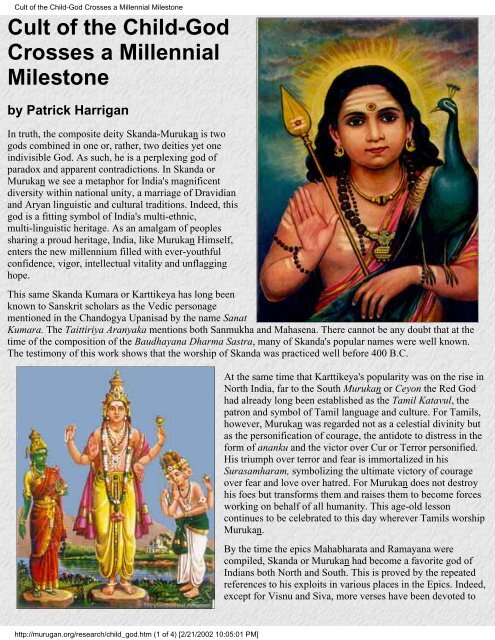
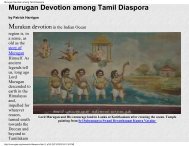
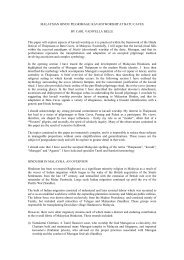
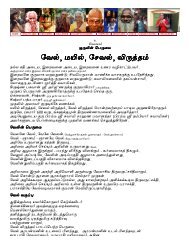
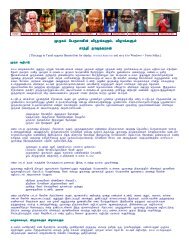
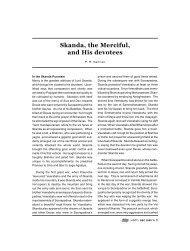
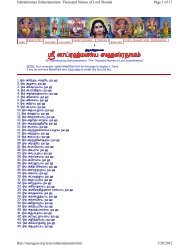
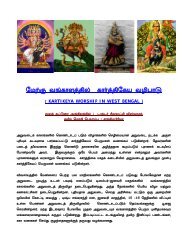
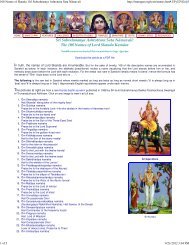
![gHdp k]y Myaj;jpw;F ghj ahj;jpiu fpuhkpa gHf;f Kiwfs;](https://img.yumpu.com/10245948/1/184x260/ghdp-ky-myajjpwf-ghj-ahjjpiu-fpuhkpa-ghff-kiwfs.jpg?quality=85)

